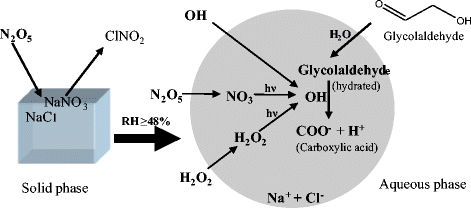Ozone and SOA formation from ethylene
组内消息 2015-09-11
High light:
液态海盐颗粒可以减少乙烯光氧化生成的臭氧
小分子乙烯降解产物可以在颗粒水中生成二次有机气溶胶

The formation of ozone and secondary organic aerosol (SOA) from ethylene-NO x -NaCl(aerosol) irradiations was studied under various relative humidity (RH) conditions in an indoor smog chamber. In the absence of NaCl seed aerosols, SOA was hardly formed and peak O3 concentrations decreased linearly with increasing RH in ethylene irradiations. For the irradiations with NaCl seed aerosols, when RH <48% (efflorescence relative humidity of NaCl), NaCl existed as solid phase and had little effect on peak O3 concentrations. The infrared spectra from sampled particles showed that SOA was rarely formed on solid NaCl particles. However, when NaCl was in the aqueous phase as RH ≥ 48%, the peak O3 concentration was sharply reduced by over 20 % as compared to experiments without NaCl aerosol, and the absorption of NaNO3 in aerosols was coincidently increased with RH. Model results indicated that the heterogeneous reaction of N2O5 with aqueous NaCl aerosols was the main cause for the sharp decrease of O3. Besides, the absorptions from C-H, C = O, ONO2 and COO groups all greatly increased with RH. Our results show that SOA from ethylene-NOx irradiations was mainly formed through aqueous reactions. The yields of SOA from ethylene were measured to be 1.5 and 2.3% at RH of 65 and 84%, respectively.
Jia, L.; Xu, Y. Ozone and secondary organic aerosol formation from Ethylene-NOx-NaCl irradiations under different relative humidity conditions. J. Atmos. Chem. 2016, 73(1):81-100; doi:10.1007/s10874-015-9317-1
full text




